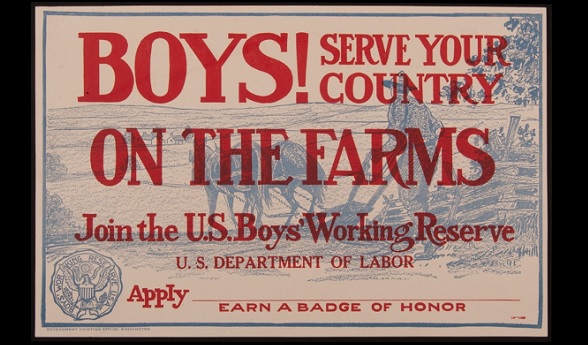
'Over Here,' Athletes Gave to WWI Effort
March 28, 2018
By Ron Pesch
Special for Second Half
In a nation at war, the needs of many outweigh the desires of a few.
Among the many noble sacrifices for the greater good was Michigan’s spring high school sports season of 1918.
The United States’ entry into “The Great War” (today commonly known as World War I) came on April 6, 1917, 2½ years after the war had begun. First elected President of the United States in 1912, Woodrow Wilson earned re-election in 1916 under a platform to keep the U.S. out of the war in Europe. The sinking of the British passenger ships Arabic and Lusitania in 1915 caused the death of 131 America citizens, but did not invoke entry into the conflict. However, continued aggressive German actions forced a reversal in policy.
“The present German submarine warfare against commerce is a warfare against mankind,” stated Wilson in an April 2 special session of Congress, in requesting action to enter the war.
A huge baseball fan, President Wilson recognized the value of entertainment and athletics during a time of crisis. Major league baseball, America’s pastime, completed a full schedule in 1917. A former president at Princeton University, on May 21, 1917, Wilson addressed the value of school athletics in a letter to the New York Evening Post.
 “I would be sincerely sorry to see the men and boys in our colleges and schools give up their athletic sports and I hope most sincerely that the normal courses of college sports will be continued so far as possible, not only to afford a diversion to the American people in the days to come when we shall no doubt have our share of mental depression, but as a real contribution to the national defense. Our young men must be made physically fit in order that later they may take the place of those who are now of military age and exhibit the vigor and alertness which we are proud to believe to be characteristic of our young men.”
“I would be sincerely sorry to see the men and boys in our colleges and schools give up their athletic sports and I hope most sincerely that the normal courses of college sports will be continued so far as possible, not only to afford a diversion to the American people in the days to come when we shall no doubt have our share of mental depression, but as a real contribution to the national defense. Our young men must be made physically fit in order that later they may take the place of those who are now of military age and exhibit the vigor and alertness which we are proud to believe to be characteristic of our young men.”
Despite the highest of hopes, the requirements and realities of war deeply impacted life in the U.S. soon after.
In February of 1918, a proposal was circulated by Dr. John Remsen Bishop, principal of Detroit Eastern High School and president of the Michigan Interscholastic Athletic Association, to abolish spring athletics at Michigan high schools. Due to a labor shortage brought on by the war, the states, including Michigan, needed help on farms, harvesting crops from spring until late fall. The action might also affect the football season of 1918.
The Boys’ Working Reserve, a branch of the U.S. Department of Labor, was organized in the spring of 1917 and designed to tap into an underutilized resource to help address that labor deficiency. “Its object was the organization of the boy-power of the nation for work on the farms during the school vacation months.”
While the idea was popular among schools around Detroit, due to the lack of public commentary from outstate school administration, it was expected that the proposal would meet at least some opposition when the M.I.A.A. gathered on Thursday, March 28 in Ann Arbor during a meeting of the state’s Schoolmasters Club.
Less than two weeks prior to the March meeting, Michigan Agricultural College made an announcement that would impact one aspect of the coming spring sports season.
“The department of athletics of the Michigan Agricultural College begs to inform the high schools of the state that plans for the annual interscholastic track meet, which was to have been conducted here in June, have been given up this year – not through any desire on the part of this department to discourage athletics, but because this is a time when we can and should devote our resources to better uses,” said coach Chester L. Brewer of the Aggies to the Lansing State Journal. “It would hardly be sound judgment for us to make our usual elaborate plans for this meet while our government is appealing to all of us to economize and exercise the utmost thrift. Neither is it wise policy to encourage unnecessary traveling upon the railroads, or to ask high schools of the state to make any expenditures other than those which are absolutely necessary.”
Earlier in the year, similar news had come from the University of Michigan.
In January of 1917, the University of Michigan had announced plans for an elaborate annual high school basketball invitational, designed to identify a Class A state champion. Billed as the “First Annual Interscholastic Basket Ball Tournament,” the March event hosted 38 teams. However, influenced by the war, a decision had been made not to run a second tournament in 1918. Instead, on March 27, Kalamazoo Central and Detroit Central, two of the state’s top teams, were invited to Ann Arbor for a hastily arranged contest at U-M’s Waterman Gymnasium. The schools had split a two-game series during the regular season. Kalamazoo won the season’s third matchup, and while not official, declared itself 1918 Michigan state champion.
Into this environment of patriotism and uncertainty, school administrators arrived in Ann Arbor for the Schoolmasters gathering. There, in the morning, the membership heard a presentation from H. W. Wells, assistant and first director of the Boys’ Working Reserve. “The heart of the nation, rather than the hearts of the nation, is beginning to beat. War is making us a unit,” said Wells, discussing the aim to recruit boys between the ages of 16 and 21 to help provide food for the allies in Europe and at home in the United States.
 “Wells told of the need for the farmers to sow more wheat, and plant more corn,” reported the Ann Arbor News, “and in the same breath he told of great corn fields all over the country, where last year’s corn still lay unhusked, because of a lack of farm labor.”
“Wells told of the need for the farmers to sow more wheat, and plant more corn,” reported the Ann Arbor News, “and in the same breath he told of great corn fields all over the country, where last year’s corn still lay unhusked, because of a lack of farm labor.”
It was estimated that 25 percent of the nation’s farm workforce was now active in the armed forces.
The proposition was brought to the M.I.A.A. by Lewis L. Forsythe, principal at Ann Arbor High School, who would soon establish himself as a guiding force in high school athletics. The proposal “was discussed thoroughly.”
“This session is usually a stormy one, because of contentions that arise over rulings that affect schools in different ways,” said Adrian superintendent Carl H. Griffey to the Adrian Daily Telegram, “but this meeting was a serious one in which all matters were related to our national welfare and passed by unanimous votes.”
So, one day after the conclusion of the abbreviated state basketball championship contest, the spring prep sports season in Michigan came to an abrupt halt. Michigan’s male high school students were asked to work to support the war effort.
“Chances are that they will remain there for the duration of the war,” stated the Lansing State Journal in response to the action. “At the meeting … it was talked of quitting football because of the need of the boys staying on the farms till the latter part of November. This is highly probable. If it is passed upon then Michigan high schools will have but one sport, basketball.
“Whether intra-mural sports will replace the representative teams is not known. This form of athletics demands the attention of a great number of teachers to tutor the different class organizations. The teachers are taxed to the limit at present and cannot give the time to sports. Organizing farm classes and Liberty bond teams is taking the teacher’s spare moments. … But still athletics are needed, as the war has demonstrated, and physical training should be instituted from the kindergarten to the university.“
“Those lads who leave for the farms the first of May,” wrote the Port Huron Times-Herald, “will be in better condition when they return home from the fields and cow lanes than they would (have) had they remained in the city until June batting the leather pill.”
The fate of the 1918 football season would not be known until late August.
In late June, the 29th Governor of Michigan, Albert E. Sleeper, thanked the estimated 8,000 students who had joined the ranks.
 “To you soldiers of the soil I would say this, that I am as proud to address you as I would be to address any of the boys who are bearing arms for their country. You have proved that you are true patriots, for you have started out to do exactly what your country has asked you to do – the thing which you can do best for your country at this time.
“To you soldiers of the soil I would say this, that I am as proud to address you as I would be to address any of the boys who are bearing arms for their country. You have proved that you are true patriots, for you have started out to do exactly what your country has asked you to do – the thing which you can do best for your country at this time.
“Every day, in the rush of official work, I think of you Reservists as you work on the farms, just as I think of our soldiers who are in training camps or ‘over there.’ And I am just as proud of you as I am of them. So are all the people of Michigan.”
It was estimated “the boys who last spring left their high school studies and as members of the United States Boys’ Reserve have helped the Michigan division to add $7,000,000 to the food production of the nation.”
In September, Byron J. Rivett, secretary of the M.I.A.A., announced that, based on a vote of member high schools, prep sports would be resumed in the fall. The Detroit News celebrated the news that “moleskins and pigskins will be in evidence and the grand old game will be a part of the autumn’s entertainment.”
In October, in Grand Rapids and Detroit and other cities across the state, officials gathered to honor those who served as part of the “Michigan Division of the Reserve” and to award bronze badges in recognition for their contribution to the war effort.
World War I officially ended on November 11 with the signing of the armistice. Armistice Day, today known as Veteran’s Day, was first celebrated in 1919. In total, an estimated 16 million were killed during the war.
“Four million ‘Doughboys’ had served in the United States Army with the American Expeditionary Forces (AEF). Half of those participated overseas,” said Mitchell Yockelson in Prologue magazine, a publication of the National Archive. “Although the United States participated in the conflict for less than two years, it was a costly event. More than 100,000 Americans lost their lives during this period.”
More than 5,000 of those casualties had come from Michigan.
***
 To the surprise of the world, a second war arrived in 1918. This one did not discriminate based on geographic or political borders. It would take more lives than World War I.
To the surprise of the world, a second war arrived in 1918. This one did not discriminate based on geographic or political borders. It would take more lives than World War I.
Globally, the Spanish Flu pandemic arrived in three waves, one in the spring, one in the fall of 1918, and a third arriving in the winter of 1919 and ending in the spring. It, too, would impact high school and college athletics in Michigan and beyond, as countless football games across the nation were cancelled in an attempt to help reduce the spread of the disease.
In the end, an estimated 675,000 would die in the United States from the virus. In Michigan, hundreds succumbed in October 1918 alone. In Detroit, between the beginning of October and the end of November, “there were 18,066 cases of influenza reported to Detroit’s Department of Health. Of these, 1,688 died from influenza or its complications.” Worldwide, an estimated 50 million were killed by the Influenza pandemic of 1918-1919.
 Ron Pesch has taken an active role in researching the history of MHSAA events since 1985 and began writing for MHSAA Finals programs in 1986, adding additional features and "flashbacks" in 1992. He inherited the title of MHSAA historian from the late Dick Kishpaugh following the 1993-94 school year, and resides in Muskegon. Contact him at [email protected] with ideas for historical articles.
Ron Pesch has taken an active role in researching the history of MHSAA events since 1985 and began writing for MHSAA Finals programs in 1986, adding additional features and "flashbacks" in 1992. He inherited the title of MHSAA historian from the late Dick Kishpaugh following the 1993-94 school year, and resides in Muskegon. Contact him at [email protected] with ideas for historical articles.
PHOTOS: (Top) The U.S. Department of Labor recruited high school students to work on farms as soldiers went oversees to fight World War I. (Middle top) A Working Reserve badge. (Middle) Lewis L. Forsythe. (Below) Another recruitment poster for the Working Reserve shows a man plowing a field while war rages in the background. (Photos collected by Ron Pesch.)
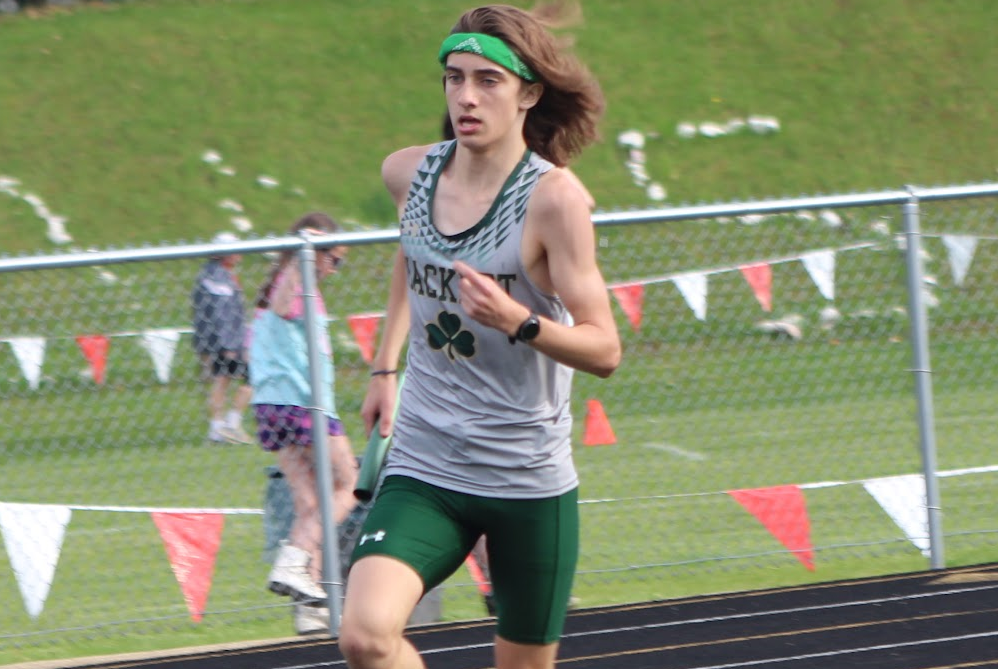
Hackett on Track to Roll Again with Distance Ace Among Those Leading Charge
By
Pam Shebest
Special for MHSAA.com
March 12, 2024
KALAMAZOO — After breaking one track record as a freshman, Marek Butkiewicz already has his eyes on two more.
 Not bad for a runner who did not even plan to run track during his years at Hackett Catholic Prep, a surprise to co-coach Shelly Germinder.
Not bad for a runner who did not even plan to run track during his years at Hackett Catholic Prep, a surprise to co-coach Shelly Germinder.
“I had heard plenty about him from some of the ultras (marathons) and different other races he had done,” Germinder said. "His commitment to the sport came through before we ever laid eyes on who he was. We knew he was going to be an asset to us.”
The current sophomore was not so sure.
“At the end of cross country (freshman year), I didn’t even think I wanted to do track,” Butkiewicz said. “Then I did it and it was ‘This is kind of fun.’
“I was good at it. I honestly didn’t have any desire going into (track season), and then I ran a couple fast times and I thought, ‘I can actually do this.’”
Butkiewicz said his freshman cross country season in 2022 was the first time he really took running seriously, and his interest was boosted when he ran a 17:31 at the Kalamazoo Christian Invitational.
“I was super happy to get the freshman record there,” he said.
This past season, Butkiewicz shattered Hackett’s sophomore cross country record, running a personal best 16:12.2 at the MHSAA Lower Peninsula Division 4 Final, demolishing the record set by Bryan Martin (16:56) in 2000.
That record also has special meaning to Germinder. Martin is her brother.
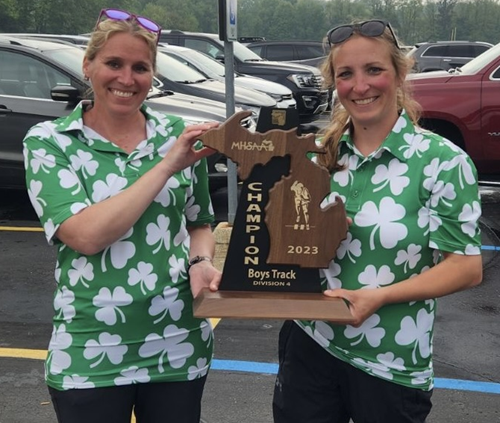 The Irish finished in third place at the Final last fall, one point behind Holland Calvary Christian.
The Irish finished in third place at the Final last fall, one point behind Holland Calvary Christian.
With the start of the spring sports season this week, the Hackett boys are hoping to make it three Finals track & field titles in a row and five over six years.
Last year’s boys team made it a sweep, winning the Southwestern Athletic Conference, Regionals, MHSAA Finals and Michigan Interscholastic Track Coaches Association (MITCA) Team State Finals.
The boys and girls teams also earned MITCA Division 4 academic awards, the girls with a cumulative 3.986 GPA and the boys with a 3.909 GPA.
This year’s team has grown from a combined 54 athletes last year to 64 with 38 boys and 26 girls.
“I think the students as a whole are seeing the successes of the team, but I also think it’s some of the flexibility we have in our sport,” Germinder said. “We know there are kids who want a dual sport and want to be involved in other things, and we want that for them, too.
“In a small school, we can’t be successful if we don’t have kids involved in multiple sports because there just aren’t enough bodies.”
Co-coach Charissa Dean said this year’s boys team will have a different look.
“We lost Liam (Mann), who was a really strong sprinter, and he left some big shoes to fill,” she said. “We have a nice nest egg of freshmen and sophomores.
“We had a junior (Gabe Oeurn) last year who is coming into his own, if you look at his track record from freshman to sophomore to junior. Last year, we had Sam Finley who was a freshman, and a sophomore (Jude Coffman) who was first time out.”
Lofty goals
Butkiewicz’s goal is to break his own school 3,200-meter record plus the 1,600-meter record, currently held by Jose Garza (4:27.4 set in 1976).
He’s pursuing a 9.25 in the 3,200 and 4.20 in the 1,600, while his long-term goal is breaking four minutes, hopefully running at a Division I university.
“His dedication, his commitment,” Germinder said. “You can’t teach that. That’s something he does on his own that comes from within. Snow, rain, whatever it is, he’s out there running, no matter what.”
The sophomore said he had no clue about records when he was a freshman, but after turning in a 10:37 in his first 3,200, then 10:05 followed by a 10 flat, he realized a record was in reach.
Butkiewicz credits his dedication for his success.
“I put in hundreds of miles a month, thousands a year, just into grinding and working toward goals,” he said. “I’ll shoot for 40-45 (miles) in-season. Offseason, when I’m building my aerobic base, I want 50 and upwards.”
As a freshman, he found a running buddy in then-junior Gavin Sehy.
“He was the fastest for the past two years and I was a little ahead of him, so we just stuck with each other and trained together,” Butkiewicz said. “Over the winter we started doing a couple miles together.”
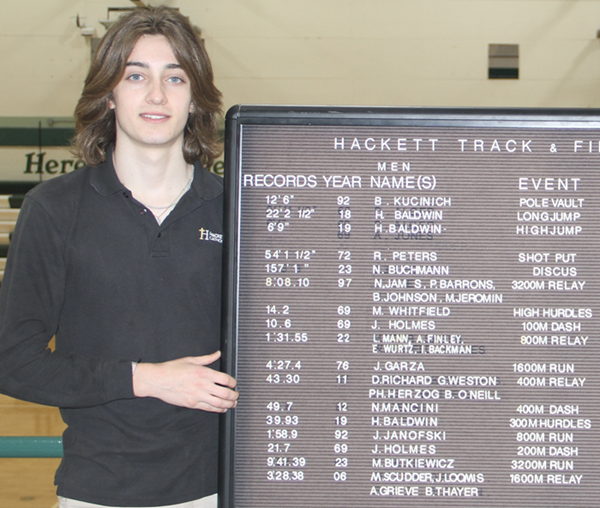 Sehy, who is headed to Southwestern Michigan College in the fall, is shooting to break the school’s 800 record plus the 3,200 running with Nick Doerr, Alex Dumont and Butkiewicz.
Sehy, who is headed to Southwestern Michigan College in the fall, is shooting to break the school’s 800 record plus the 3,200 running with Nick Doerr, Alex Dumont and Butkiewicz.
Sehy was also a running buddy in cross country, finishing second on the team at 16:21.
“(Sehy) always had the potential, but it wasn’t until Marek came along that he started doing that training in the summer,” Dean said. “It has made a massive difference.”
Sehy and Butkiewicz competed in two ultramarathons (more than 26.2 miles) over the summer.
“I had never ran a marathon before, but somehow Marek convinced me to run 38 miles at Kettle Moraine State Forest (Wisconsin),” Sehy said. “And I did. Later in the summer, I ran 50 in Holly, Michigan.”
In the Wisconsin ultra, Butkiewicz was trying to finish the 100-mile run with Sehy pacing him for about 40 miles.
“I ended dropping at mile 75 because of some hip issues but he kept going and finished it,” Butkiewicz said. “The second one in Holly, I was doing 100 miles and he was doing 50, so we pretty much ran together for the first 50.”
Sehy said the two share the same mentality, which makes it easy to have a training buddy.
“We both really want it so bad, and we’re not afraid to do crazy things to get it,” he said. “Last year, during track, we needed to get some more miles in but just ran out of time during the week, so Sunday night we were out running 18 miles until after the sun went down out in the forest.”
Germinder said Sehy has noted he needs to have another runner to really push him.
“That’s one of the really beautiful things about the relationship they have,” she said. “It’s a healthy competition between them, but they want what’s best for each other, too.”
Butkiewicz lives near a land preserve where the two do much of their training, no matter what the weather, and they make it fun, jumping icy puddles and eating berries along the way.
“The coldest day of the year we ran with no shirts just because we could,” Sehy laughed.
When Sehy isn’t available to train, “I’ve been training a lot with Sean Siems; he’s a sophomore, a huge rising talent,” Butkiewicz said.
New year, new leaders
This year’s team will have a different look.
“We lost Liam and Bryce Brown and Nathan Buchmann (discus and only individual Finals champ),” Sehy said. “It’s tough to lose your best guys, but I think we have so much depth on this team, I think we’ll be all right.”
Just two weeks into the young season, Hackett will be on spring break, so many of the athletes pushed the coaches to schedule a meet before then.
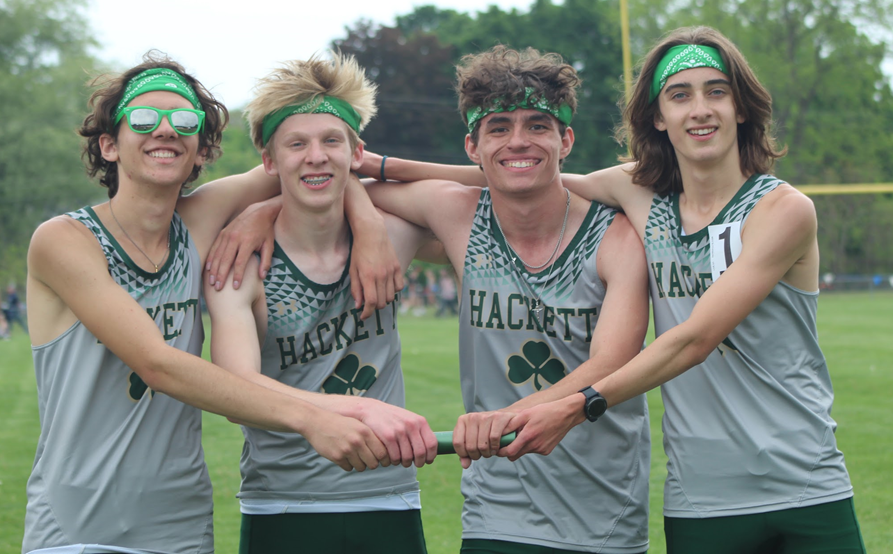 They found one in the Onsted Early Bird Meet on March 20.
They found one in the Onsted Early Bird Meet on March 20.
“They want to see where they are going into spring break to know, is there extra work we need to do during spring break,” Germinder said. “Having a competition will tell them where they’re at.
“If you do nothing (over spring break), then you’re starting all over again. I think a lot of our athletes recognize that and know they have to work a little more.”
Besides Butkiewicz and Sehy, leaders on the team include pole vaulters/sprinters Jack Prom and Lauren Wild.
“Keegan Gallagher is our biggest cheerleader and keeps the team in good spirits,” Germinder added. “He brings something that isn’t just on the track.”
With such large numbers, “If they’re not competing, we like to take them with us on the bus anyway,” Dean said. “They can help support their teammates, they can run a stopwatch, they can take video of the relay handoffs so we can go back and look at it later.”
In spite of the success on the track or in the field, Germinder said she is most proud of the athletes as people.
“With that leadership comes responsibility of good sportsmanship, how they’re interacting with other teams on the line,” she said. “I love watching our boys praying together with other teams before they’re getting ready to run. Or shaking hands before or after, especially sprinting events. It says a lot about who we are.”
 Pam Shebest served as a sportswriter at the Kalamazoo Gazette from 1985-2009 after 11 years part-time with the Gazette while teaching French and English at White Pigeon High School. She can be reached at [email protected] with story ideas for Calhoun, Kalamazoo and Van Buren counties.
Pam Shebest served as a sportswriter at the Kalamazoo Gazette from 1985-2009 after 11 years part-time with the Gazette while teaching French and English at White Pigeon High School. She can be reached at [email protected] with story ideas for Calhoun, Kalamazoo and Van Buren counties.
PHOTOS (Top) Kalamazoo Hackett Catholic Prep’s Marek Butkiewicz rounds a curve during a race last season. (2) Butkiewicz shows the school record board, including his 3,200 entry earned last season. (3) Hackett track coaches Charissa Dean, left, and Shelly Germinder hold up last season’s MHSAA Finals championship trophy. (4) The Hackett 3,200 relay, from left: Gavin Sehy, Alex Dumont, Nick Doerr and Butkiewicz. (Action, coaches and relay photos courtesy of the Kalamazoo Hackett Catholic Prep boys track & field program; record board photo by Pam Shebest.)

